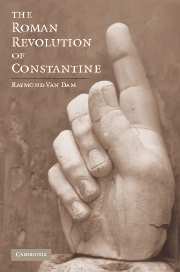Book contents
- Frontmatter
- Contents
- PREFACE
- ABBREVIATIONS
- Map
- Introduction: AUGUSTUS AND CONSTANTINE
- SECTION I A ROMAN EMPIRE WITHOUT ROME
- 1 CONSTANTINE'S RESCRIPT TO HISPELLUM
- 2 HIS FAVORITE ROOSTER: OLD ROME AND NEW ROME
- 3 “HOPE IN HIS NAME”: THE FLAVIAN DYNASTY
- 4 READING AHEAD
- SECTION II A GREEK ROMAN EMPIRE
- SECTION III EMPEROR AND GOD
- Epilogue: ONE EMPEROR
- APPENDIX 1 HISPELLUM: DATE, TEXT, AND TRANSLATION
- APPENDIX 2 ORCISTUS: DATES, TEXT, AND TRANSLATION
- EDITIONS AND TRANSLATIONS
- BIBLIOGRAPHY
- INDEX
2 - HIS FAVORITE ROOSTER: OLD ROME AND NEW ROME
Published online by Cambridge University Press: 05 June 2012
- Frontmatter
- Contents
- PREFACE
- ABBREVIATIONS
- Map
- Introduction: AUGUSTUS AND CONSTANTINE
- SECTION I A ROMAN EMPIRE WITHOUT ROME
- 1 CONSTANTINE'S RESCRIPT TO HISPELLUM
- 2 HIS FAVORITE ROOSTER: OLD ROME AND NEW ROME
- 3 “HOPE IN HIS NAME”: THE FLAVIAN DYNASTY
- 4 READING AHEAD
- SECTION II A GREEK ROMAN EMPIRE
- SECTION III EMPEROR AND GOD
- Epilogue: ONE EMPEROR
- APPENDIX 1 HISPELLUM: DATE, TEXT, AND TRANSLATION
- APPENDIX 2 ORCISTUS: DATES, TEXT, AND TRANSLATION
- EDITIONS AND TRANSLATIONS
- BIBLIOGRAPHY
- INDEX
Summary
This feuding among regions and cities in central italy was now incidental to imperial concerns, because increasingly central Italy itself had become peripheral. So had the city of Rome. At the end of the third century a Gallic orator described a map of the Roman world that was being painted on the wall of a new school at Autun. This map highlighted the regions where the four emperors who made up the Tetrarchy had enjoyed recent military successes. Those regions included Egypt, where Diocletian had suppressed a rebellion; Africa, where Maximian had defeated the Moors; Batavia and Britain, where Constantius had overthrown a usurper; and the eastern frontier, where Galerius had triumphed over the Persians. The orator did not mention Rome. If the map had provided a caption for Italy and Rome, then the absence of an emperor and his court would have been all the more glaring. The emperors now resided and campaigned in the frontier zones that enclosed the Roman world and rarely visited the provinces around the Mediterranean center.
THE OUTER RIM
This map still noted the activities of emperors in Africa and Egypt. Soon emperors no longer visited those regions either. Constantine's reign confirmed the shift in political significance from the western and southern regions of the empire to the eastern and, especially, the northern regions. Centuries earlier, Roman armies had first expanded outside Italy in campaigns against the rival empire of Carthage in North Africa.
- Type
- Chapter
- Information
- The Roman Revolution of Constantine , pp. 35 - 78Publisher: Cambridge University PressPrint publication year: 2007

